THE YOUNGEST BELGIAN CHEF AWARDED
3 MICHELIN STARS
Text ©2013
Photos ©2013 by Kristof Vrancken
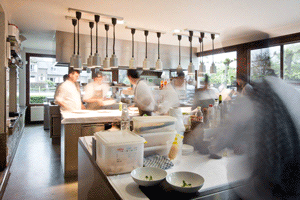
kitchen at Hertog Jan
I first heard of Gert de Mangeleer and his partner Joachim Boudens (voted the best sommelier of Belgium in both 2005 and 2011) from Geert Van Hecke, the first Flemish chef to be awarded three Michelin stars which he has kept since 1996. My interview with Van Hecke was published in Epicurean-Traveler.com in August 2012 only a few months after de Mangeleer and Boudens’ restaurant “Hertog Jan,” in Sint-Michiels just outside Bruges, had been awarded its third Michelin star.
I first met de Mangeleer, who had never been to Italy before, last February at Identità Golose where I interviewed him exclusively for Epicurean-Traveler.com.
Born on July 22, 1977 in Dendermonde, Gert, a good student, was destined to become an engineer, but after high school he decided to follow his dream and learn to cook. He learned the tricks of the trade at “t Molentje” in Zeebrugge, working for four years with star chef Danny Horseele. There he also met Joachim Boudens, with whom in July 2005 he took over Guido Francque’s restaurant “Hertog Jan.” Eighteen months later they were awarded their first Michelin star for the 2007 guide. On November 23, 2009 they received their second for the 2010 guide and on November 21, 2011 their third for the 2012 guide.
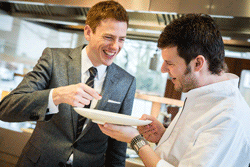
Sommelier Joachim Boudens & Chef Gert de Mangeleer
Our tastes in food are closely connected to our childhood; what are your first memories of food?
GM: My mother’s Pain de Veau, bread-crumbed meatballs cooked with chopped onions, garlic, parsley, mustard, potatoes and cherries. It looks like a meat loaf and the outside is caramelized.
I also remember that when I was a little child my mother was always baking bread and cakes. I can still smell the aromas of her kitchen when I came home from school. From the time I was 7 or 8 I helped her to bake, especially apple pies, and loved licking off my fingers what remained in the mixing bowls.
Why and when did you decide to become a chef?
GM: I wanted to be a chef from the time I was 12, but I was quite a good student at school so my parents said to me: “You have good grades so you should stay and graduate from school. Then, when you are 18, you can still choose to become a cook. Otherwise, if you go to hotel school at 12 years old, you won’t have a strong cultural base.” At 18, I decided to start university in Louvain, but as soon as I arrived there to register, I took the train back to Bruges and started hotel school. So I was 18 or 19 when I started cooking.
Who were your mentors and what did you learn from them?
GM: I’ve never really had a mentor at least not in the kitchen. I had a chance to become a chef very early, when I was about 22, in a restaurant in Zeebrugge, which doesn’t exist anymore. Its name was “t Molentje,” which means “a little windmill” in Flemish. It already had one Michelin star thanks to its star chef Danny Horseele. I was given carte blanche and we were awarded our second star. I wouldn’t be so boastful as to say that I’m a self-made man, but in the kitchen I have my own style of cooking, I think because I never had a mentor. I was forced to go my own way, do my own thing and create my own style. At the beginning it was very difficult, but now 15 years later, I think that learning through your own experimentation and mistakes is the best way.
But you said you had a “mental mentor;” what do you mean by this?
GM: Someone who helped me understand gastronomy, taught me how to invest in myself, who’s always supported me from the beginning of my career, and who means a lot to me is Guido Francque, who is my manager. He organized this interview, for example. He started Hertog Jan in 1991 as a wine bar and bistro. It was his until 2005 when Joachim and I took over.
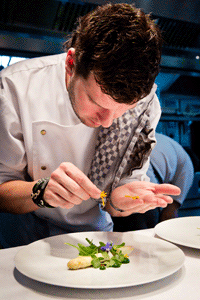
Chef Gert de Mangeleer
Hertog Jan was a local Duke (John I, Duke of Brabant (1252-1294) and a very successful warlord. Every time he won a war he organized very big gastronomic festivities with his subjects. So there’s a beer named after him. He was seen as the “Lord of the Good Life.” Hertog means Duke in Dutch.
When you heard that you won your first Michelin star, what was your reaction?
GM: I was giving my daughter Myrthe, who was 2 years old then, a bath when I got a phone call from Peter Goossens, the chef of “Hof van Cleve.” I started shouting and shouting with joy, but Myrthe started to cry. She’d never seen me like that and thought that something bad had happened.
When I got my second star it was also a very emotional experience, but the third star in November 2011 was the most special. I found out from a Michelin press release and I still get goose bumps when I think of it. No restaurant in Belgium had received a new third star in the 7 previous years. The press release was issued at a press conference in Ghent. All the Belgian chefs at two-star restaurants had to sit in the front row. At the end of the press conference the Michelin PR director announced, “Yes, by the way, we have a new three-star.” Everyone was silent and nervous waiting to know who got the third star. It was an unforgettable moment.
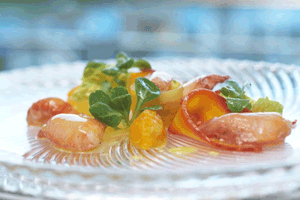
Lobster with cocoa and vanilla
Do you feel enormous pressure to keep that third star?
GM: Not really, because it was recognition of the hard work we did and still do. Of course, there is some pressure but we are all young so, if we keep working the way we do and continue to innovate and grow (we have lots of time to grow and improve), it’s a good omen for us to keep our third star. I see that we still have a lot of potential. I don’t think about the third star every minute of the day; I just continue to do my best and still grow. Those are the most important factors.
What are the essential qualities of a top chef?
GM: Creating your own style, making no compromises, doing your own thing and keeping on doing your own thing, being creative and innovative while remaining respectful of nature and ingredients and never resting on your laurels. A top chef must always invent new dishes.
What do you like best about your job?
GM: I like everything about my profession. It’s a beautiful job. I meet lots of people, travel to lots of places, work with the best available products, make delicious food, and offer top hospitality.
The least?
GM: Nothing really because my wife is in charge of all my paperwork, paying the bills, salaries and taxes.
What’s your culinary philosophy?
GM: Our motto is “simplicity is not simple.” It’s very important to me to let my ingredients speak for themselves, but give them my personal twist. My creations are striking for their contrasts: tender/crunchy, salty/bitter, hot/cold.
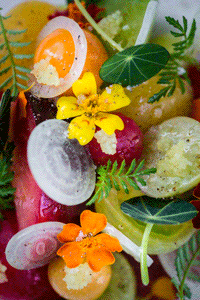
The Tomato Collection
In a nutshell how would you define your cuisine?
GM: Honest, respectful, and close to nature. Food pairing is creating a platform of opportunities to support the original taste of culinary products. Beside the individual products, food and wine pairing are also essential.
What are your signature dishes, other specialties?
GM: Our signature product is the tomato. We grow our own. Last summer, in 2012, we had 69 different types of cherry tomatoes, all different shapes, colors, and flavors. For example some tomatoes taste like strawberries. Some look like pears. We have black ones; some are purple.
One of our signature dishes is called “The Tomato Collection.” We start to plant them in February. We peel them by hand. We give every guest “The Tomato Collection.” One of our specialties is fresh goat cheese topped with our tomatoes, spring onions and flowers from the farm, but only from mid-July to the beginning of October. Afterwards we serve cold tomato water with some acidity in it. “A Walk Through the Garden” is another of our signature dishes. Everyday it’s different. It’s in honor of Michel Bras. Everyday in the early morning I take a walk with our gardener, Bart Praet, and we pick the herbs, flowers, and vegetables that are ready, and then we make our “Walk Through the Garden” of the day. It’s always on the menu. The specialty of our main courses is lobster with cocoa and vanilla, and of our desserts dark chocolate ice cream with cherries and black truffles (the tuber not the ice cream).
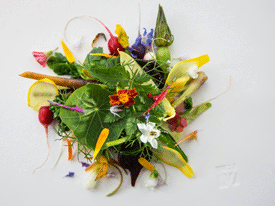
Walk Through Garden
Your partner Joachim Boudens worked with Geert Van Hecke, right?
GM: Yes, when he was about 20. I think it was an internship while he was still in school. Now he is 37.
What do you think are the reasons for your success?
GM: I think it’s because where other people stop, we go further. For me some people are happy and satisfied with their work too fast. I don’t rest on my laurels. I push my limits farther and farther.
What do you think of food critics?
GM: Media is very important. Food critics have been helpful to me. During the last few years I’ve received many favorable reviews.
Why do you think there are so many starred restaurants and emerging chefs in Flanders?
GM: I agree with your observation, but don’t ask me why. I don’t know the reason. It’s true that wherever you go in Flanders, you almost always eat very well. Even in brasseries and simple places, you find excellent ingredients and preparation. Maybe it’s because we have Geert Van Hecke, Pieter Huys, the godfathers of Flemish gastronomy. Over the years they both had many disciples who’ve stayed in the region. In Flanders and the rest of Belgium cooking is hot. We have many TV programs and magazines about cooking. Everyone seems to want to be a good cook, but it’s a difficult question: Why? But it’s a fact that there are lots of good restaurants with young chefs throughout Belgium, but especially in Flanders.
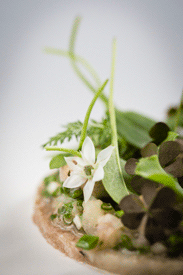
Pork trotter with sorel clover and starflower
Why are Belgium’s top restaurants concentrated in Bruges?
GM: Probably because Bruges is a lovely place and home to Ter Groene Poorte, one of the best hotel schools in Belgium, where I went.
Up to now we’ve talked about Gert de Mangeleer the chef; I’d like to know more about Gert de Mangeleer the person. For example, what are your favorite foods?
GM: Steak Tartare.
If you were on Death Row, what would you order for your last meal?
GM: Steak Tartare.
A dish you dislike?
GM: Red cabbage. I don’t like the smell of cooked red cabbage. It’s the only thing I don’t like.
Your favorite wines?
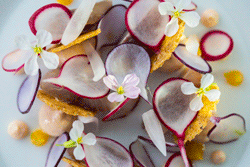
Spring radish with marinated mackerel, lemon peel crème, and escabeche of spring vegetables
GM: Chateau Rayas 2006.
Your favorite dessert?
GM: Snickers.
Your favorite color and flower?
GM: White because it’s clean. Gerbera.
What zodiac sign are you?
GM: Cancer.
Chefs are well-known for having collections, often of motorcycles, fast cars, or watches; what about you?
GM: Vintage Madeira from the 1800s and special cigars. They go well together.
Other chefs that you admire and why?
GM: I have lots of respect for Michel Bras. He is a generation older than me, but his dishes are all contemporary. He has deep respect for nature. He is a very great man.
Last weekend I was cooking in St. Moritz and had the pleasure of meeting Massimo Bottura. I tasted some of his dishes and they were really great.

Avocado with tomato powder, olive oil, and fleur de sel
If you hadn’t become a chef, what other profession would you have chosen?
GM: Architect.
Do you have a pipedream?
GM: No, because it’s a reality. In July 2014 we will move our restaurant to our farm. We are already building our new restaurant. It will have lots of picture windows so our motto will be “what you see is what you eat.” We will keep the restaurant we have now and turn it into a brasserie.
& & &
